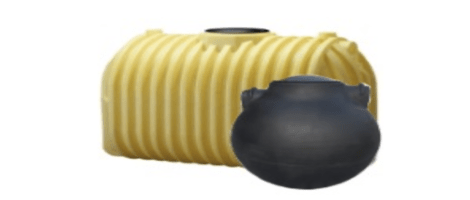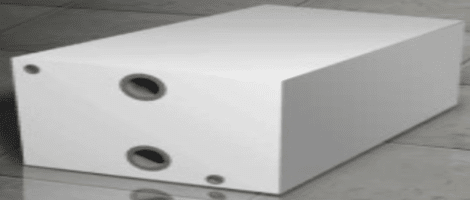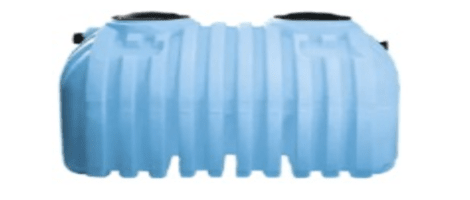Holding Tank vs Septic Tank: Uses & Cost Differences
Some people believe holding tanks and septic tanks are one and the same. Although both are forms of sanitation systems, there are various crucial differences between them. Both types of tanks collect wastewater from households, but each manages this effluent differently.
Holding tank sewage is merely stored until it's removed while septic tank sewage decomposes through contact with enzymes and bacteria. The system you elect to install in your home depends on local government regulations, soil conditions and installation cost.
Holding Tank System

A holding tank is a vessel that stores sewage and other waste until it's pumped out of the house. All wastewater from your home enters the holding tank through an inlet valve, including water from sinks, toilets, washing machines, dishwashers, showers and baths.
It's a simple water-tight container made of plastic or fiberglass that stores wastewater until it can be pumped out by a professional service. This tank needs to be emptied frequently — usually every two weeks or more — which will add to the overall cost of ownership.
Holding Tanks are Built Differently
Holding tanks are not as complex as a septic tank:
- They generally have one lid.
- There are no internal compartments.
- No partition walls are needed.
- High-level alarms are necessary to prevent accidental spillage.
Specific Applications for Holding Tanks
Holding tanks are more often used in small living spaces like trailers, RVs, boats and construction sites. They aren't created for big homes or extended periods of time, although vacation homes may benefit from a holding tank if its installation is permitted in the community.
Septic Tank System

Structurally, septic tanks resemble ordinary holding tanks but function quite differently. Septic tanks — typically made of concrete, fiberglass or plastic — are designed to treat wastewater by separating it into three layers: scum (which floats), solids (which sink) and partially clarified liquids (which flow through an outlet pipe).
Most septic systems contain a septic tank and drain field, with the former usually breaking down organic matter. With most soil-based systems, liquid effluent is discharged from the septic tank into perforated pipes that release the effluent gradually into the surrounding soil.
How a Septic Tank Works
While a holding tank performs no biological operations on its contents, a septic tank has multiple jobs simultaneously. Inside the tank, there are baffles that settle solids and prevent the scum layer of lightweight solids, fats and greases from floating out of the tank with effluent.
- Anaerobic bacteria digest settled solids without air. Some products of anaerobic digestion are gasses, including methane, carbon dioxide and hydrogen sulfide.
- Gasses escape from a septic tank through regular household plumbing vents.
- The microorganisms in the septic tank cannot break down materials such as plastics and metals, so they build up in layers of sludge or scum. If these layers are not removed periodically by pumping, the solid and grease accumulation will clog up the drain field.
Specific Applications for Septic Systems
A septic system is the preferred method of waste disposal for long-term residential or commercial use where public sewer systems are not available.
Pros and Cons of Both Systems
Holding Tanks

Pros
Because holding tanks do not require any special design or construction, they are usually cheaper than septic systems, making them ideal for areas where a septic system is not permissible due to restrictive building codes. In addition, holding tanks can last decades if properly maintained and pumped.
Cons
Holding tanks require frequent pumping, which will add to the maintenance cost. In addition, some states have strict regulations on holding tanks and may require special permits and inspections before they can be installed.
Septic Tanks

Pros
Septic tanks, when permissible, have many advantages over holding tanks. Household waste is automatically dealt with, allowing homes to be built in areas without public sewer systems. In addition, septic tanks only need occasional pumping.
Cons
If not regularly maintained, septic systems may break down and cause leaks, ruptured or clogged pipes or a flooded drain field. Not enough weight in the septic tank can lead to a broken pipe if the tank moves or floats due to flooding.
With this being said, replacing a worn system is expensive and may not be an option if soil drainage has worsened.
The final decision on which type of tank is best for you will ultimately depend on what code allows and your budget. The holding tank is less expensive to install but requires more frequent pumping. The septic tank has a higher upfront cost but requires less maintenance.
Tank Depot Has Holding Tanks and Septic Tanks for Any Application
At Tank Depot, we offer holding tanks and septic tanks for virtually any waste disposal application. Our holding tanks start at 200 gallons and septic tanks start at 500 gallons. They are designed for long-term reliability and performance in any environment — both residential and commercial applications!
Whether you need a holding tank smaller for light residential use or something larger for industrial applications, we’ve got you covered with great service and the lowest prices. Contact us today for more information.






